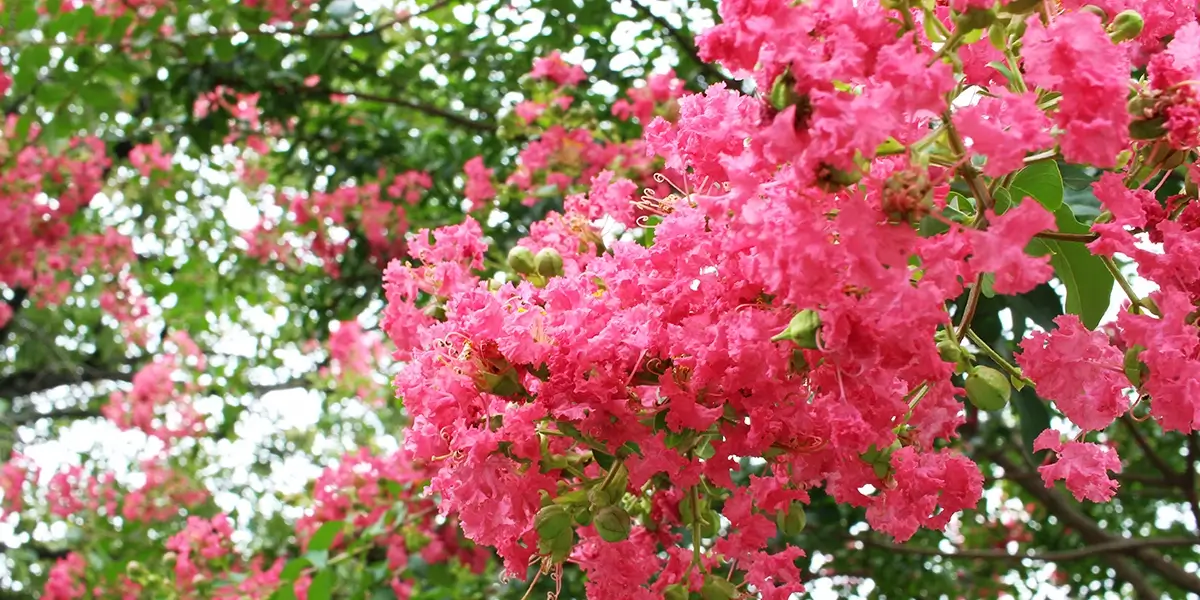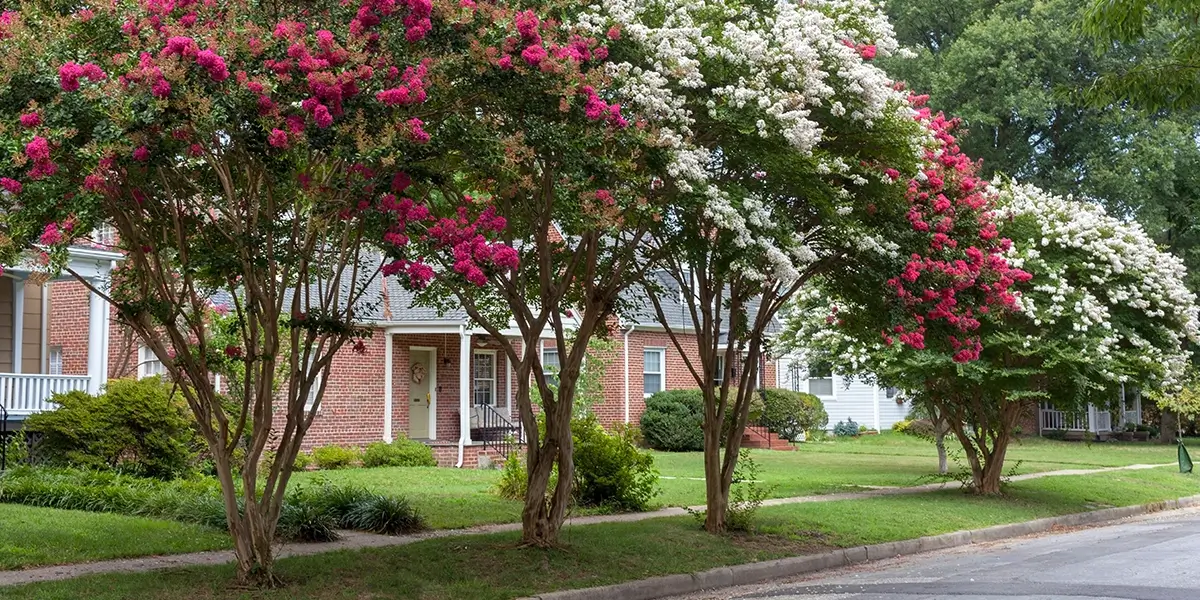Crape myrtles are one of the best warm-season landscape shrubs, producing beautiful flowers during the summer and colorful leaves in autumn. During winter dormancy, the larger crape myrtle varieties develop attractive bark.
Choosing Crape Myrtle Varieties
- Crape myrtle can be a shrub or tree.
- Mature size ranges from 2 to 30 feet.
- Upright and spreading (weeping) forms are available.
- Choose a variety of appropriate size for the location.
- Choose varieties with powdery mildew resistance for easier maintenance.
- Flower colors include white and many shades of cream, pink, red, rose, orchid, lavender, and purple.
- Some flowers have frosted or two-tone petals.
- Trunks are mottled in shades of sable, tan, and brown.
- Fall foliage color may be red, orange, or yellow.
Site Selection
- Choose an open area with as much sun as possible.
- Crape myrtles grow better and larger on light, well-drained soils.
- Ensure good air circulation to control powdery mildew (see the section on Pests & Disease).
Planting Crape Myrtle
- Dig a hole 1 to 2 feet wider than the diameter of the root ball.
- Set the top of the root ball level with the soil around it.
- a) For large balled and burlapped or container-grown plants, dig a hole the same depth as the root ball so that the top of the root ball is even with the soil line;
- b) For small plants (1 to 5 gallons), dig a hole deeper than the root ball, hill and firm the soil to set the top of the root ball even with the soil line.
- Plants set too deep or shallow grow poorly and may die.
- Build a levee of soil around the perimeter of the dug area to create a basin for thorough watering.
- Mulch area around the base of the plant with 1 to 2-inch depth of compost, composted bark, pine straw, etc.

A fuchsia flowering crape myrtle tree.
Light, Soil & Water
Crape myrtles grow best in full sunlight, with good air circulation and moist, fertile loam soil with good drainage. They can tolerate considerable heat, humidity, drought, or excessive moisture but not shade or poor aeration.
- Water crape myrtles thoroughly during dry spells.
- Water more frequently in the first two years.
- Although older plants are somewhat drought tolerant, irrigation during dry spells will enhance performance.
They prefer soil with medium to high fertility. Both soil and water should be within the pH range of 6.5 to 7.5. To hold in moisture, apply mulch around your crape myrtle plants so that only a limited amount of local water is needed. They will do better when rainfall is sufficient for them.
- Fertilize with either complete inorganic or organic fertilizer or a combination of both.
- Apply compost or other organic mulch materials to a depth of 1 to 2 inches over the soil area extending from the trunk to just beyond the spread of branches.
- Replenish organic mulch as needed.
- Apply inorganic fertilizer with a 3-1-2 ratio of N-P-K in February or March at a rate of 1/2 to 1 lb. per 100 sq. ft.; also apply 1/4 to 1/2 lb. per 100 sq. ft. or a 1-2-1 ratio of N-P-K in May or early June to encourage good bud set.
- Spread fertilizer over feeder roots in a zone extending from just beyond the drip line of the canopy to half the distance inward toward the trunk.
- Do not apply inorganic fertilizers near the trunk.
- Do not use fertilizers containing herbicides.
If conditions are poor, can they be improved for crape myrtle?
There are limits to this approach. I had to move all five of my shrubs because of bad air circulation and shade from a board fence and a tree.
- Crape myrtle grows better in moderately moist soil than in extremely dry or wet soil.
- Flowers develop on new growth. Gardeners should provide the best conditions for the roots to produce growth and blooms.
- Crape myrtle shrubs sprout multiple permanent stems. The sizes and shapes of different varieties are due to genetic traits.

Closeup of hot pink crape myrtle blooms.
Pruning Crape Myrtle
A gardener wishing to develop a tree form of crape myrtle with a single or a few trunks should select a variety with an expected tall, mature size. Then, as new stems continue to sprout at the base of the shrubs, they will have to be pruned off several times each season.
A gardener who prefers medium or small shrubs with many stems should select a crape myrtle variety with that mature size. Topping off larger plants is termed “crape murder” because nodules form at each cut, and many weak twigs grow out from them.
Limbs that cross over other limbs should be pruned, and seed pods can also be cut after the flower petals fall. I started pruning seed pods when I noticed new growth with flower buds under them.
Apparently, I was wasting my time! When it comes to flowering, moisture and soil fertility are more important than pruning.
So, choose a crape myrtle plant carefully and allow it to develop to its natural, genetically determined size and shape. It will end up being much healthier and easier to maintain.

A residential street lined with pink and white-flowering crape myrtles.
Pruning Young Plants
- Most pruning is done in the winter.
- Study branches before pruning.
- Establish a robust framework.
- Prune for safety whenever needed.
- Remove thin twigs and stems from the base and lower trunk.
- Head back stem tips to thicker, living wood.
- Cut back to just above the outward pointing bud.
- Thin out branches at their tips.
- Remove seed balls from younger plants.
- Remove branches that grow inward toward the plant’s center.
- Remove one of a pair of rubbing branches.
- Remove damaged or dead wood at any time.
Pruning Mature Plants
- Remove excess branches near the base, twiggy growth, crossing or rubbing branches, and branches growing inward.
- Thin and rejuvenate the canopy of flowering wood.
Pests & Disease
- Powdery mildew, a gray mold that appears on the surface of the leaves, is best controlled using mildew-resistance varieties of crape myrtle.
- Aphids (very small soft-bodied insects) suck sap out of leaves and weaken plants.
- Aphids excrete sticky honeydew, which accumulates on the surface of leaves and results in sooty mold (black mold that looks like soot) on the leaf surfaces.
- Control sooty mold by controlling aphids.
- Control aphids with biological controls or approved insecticides.
- Many gardeners choose to ignore aphids and mildew. Most plants will survive without treatment.
- Remove aggressive vines that shade and weaken the canopy.
FAQ: Caring for Crape Myrtle
Q: What’s the best time to plant crape myrtle in Southern California?
A: The ideal time to plant is fall or early spring. This timing allows the trees to establish their root systems in moderate temperatures before the hot summer or cooler winter.
Q: How often should I water my crape myrtle?
A: Initially, water your crape myrtle deeply once a week to help establish roots. Once established, Crape Myrtles are reasonably drought-tolerant, but during long periods of dryness, we recommend deep watering every two to three weeks.
Q: Do crape myrtles need full sun?
A: Crape myrtles thrive in full sun, requiring at least six hours of direct sunlight daily for optimal bloom and growth.
Q: When and how should I fertilize my crape myrtle?
A: Fertilize as new growth appears in early spring, using a balanced slow-release fertilizer. Avoid fertilizing late in the season, as it could spur new growth that won’t harden before winter.
Q: Do crape myrtles need pruning, and if so, how?
A: Pruning helps crape myrtles maintain their shape and promotes blooming. Prune in late winter or early spring before new growth begins. Remove dead or diseased wood and thin the canopy to allow light and air circulation.
Q: What pests or diseases should I watch out for with crape myrtle?
A: Look for aphids and Crape myrtle Bark Scale, which can be managed with appropriate insecticides. Powdery mildew can be a problem in some conditions, but selecting resistant varieties and ensuring good air circulation can help prevent it.
Q: Can crape myrtles handle Southern California’s heat and dry conditions?
A: Crape myrtles are well-suited to Southern California’s heat and occasional dry conditions. Once established, they’re drought-tolerant, making them an excellent choice for Southern California landscapes.
Q: How can I encourage more blooms on my crape myrtle?
A: Ensure your crape myrtle is planted in full sun, adequately watered, and fertilized appropriately. Deadheading spent flowers can also promote a second bloom in late summer or early fall.

